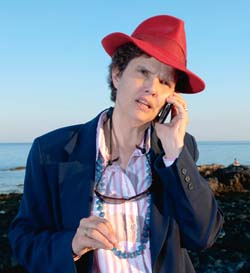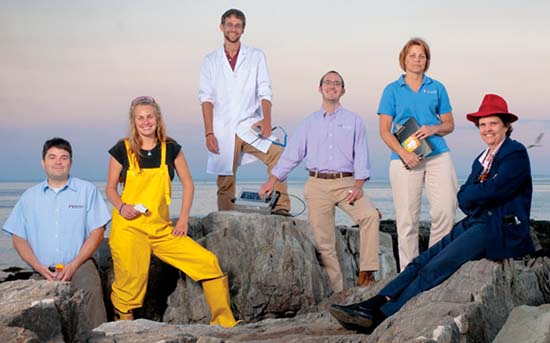 |
 |
| current issue |  | past issues |  | send a letter/news |  | address update |  | advertise |  | about us |  | alumni home |
Features
|
On Call
As the disaster in the Gulf of Mexico unfolded, UNH's Coastal Response Research Center—and its director, Nancy Kinner '80G, '83G—became the go-to source for oil spill expertise By Suki Casanave '86G Also read "Award-Winner", to learn more about the Environmental Response Management Application developed by UNH. |
Easy to print version Make a comment |
 John T. Fritz/MCT via Getty Images
John T. Fritz/MCT via Getty Images |
When the Deepwater Horizon oil rig exploded in the Gulf of Mexico on April 20, Nancy Kinner '80G, '83G was in Anchorage, Alaska, doing one of the things she does best—talking about oil and, ironically, what to do with it when it spills. Within hours, her phone started ringing. Reporters everywhere were scrambling after the story. They needed experts to interview, and they needed them fast. CNN International got to Kinner first, hoping to interview her on the evening news. But the professor of civil and environmental engineering and co-director of UNH's Coastal Response Research Center was busy trying to wrap up her final workshop session. Members of her staff waved frantically from the back of the hotel conference room, trying to get her attention. No luck. They tried exaggerated wrist-tapping. More animated gesturing. Finally, with seconds to spare, Kinner dashed next door, where, from a computer screen in Alaska she spoke to newscasters in London about the mechanics of blowouts and potential environmental impacts on the Gulf Coast. No one knew, at that point, just how bad things were going to get. By the time she returned to UNH the next day, an environmental crisis of historic proportions was unfolding. And Kinner was in perpetual demand.
In the months following the spill, the professor with a reputation on campus as "tough but caring" talked to newspaper reporters and TV personalities. She spoke from her office stacked high with papers, and she was transported to studios where she sat face to face with news anchors. She testified three times before Congress, and, at the request of the White House, Kinner and her staff mobilized emergency meetings of oil spill responders to address controversial cleanup issues. But as the drama in the Gulf continued, Kinner didn't perceive herself as a media star or an oil spill expert—she saw herself as a teacher. And she hoped everyone was paying attention. The nation, her extended classroom, was in the midst of the ultimate "teachable moment." Would the American people get the message? Would she be able to help them learn the lessons of the Deepwater Horizon?
 Lisa Nugent/UNH Photographic Services
Lisa Nugent/UNH Photographic Services |
Kinner was uniquely suited to step into the role of "internationally recognized oil spill professor," according to Amy Merten, NOAA co-director of the center. "She has a lot of credibility that other academics don't necessarily have. Nancy understands how the incident command system works during a spill, how funding works, how oil companies work with the federal government and states in trying to solve a common problem. Nancy was the only academic out there who could be a sort of neutral spokesperson—and that's because of her work with the Coastal Response Research Center."
Established in 2004 as a partnership with NOAA's Office of Response and Restoration, the center has become a hub of expertise for oil spill response and restoration research. While other university-based oil spill research centers exist, none has UNH's national focus—or the connection to NOAA. "We needed a research arm that could help oil spill responders do their jobs better," says Merten, explaining that other university centers are tied to oil-related activity in their own states. Only the center at UNH coordinates and distributes funding—nearly $5 million—to scientists around the nation.
"The center's goal has been to identify major research gaps and try to help fill them," says Merten, ticking off three of the biggies: dispersants, Arctic regions and impact on humans. One project, for example, looked at the use of dispersants to clean up salt marshes. Another looked at the recovery of oil in extreme cold-water environments. Still another tried to determine the impact of a spill on people's quality of life: How, for example, do you measure the lost value to a community of an oil-contaminated beach? "Thanks to their work over the past few years, the center was able to bring good science and good people to the Deepwater Horizon spill," says Merten.
At first, the center had to prove itself to skeptics, including a number of big oil-rich states that wondered why a little place like New Hampshire—without a drop of oil to be found seeping through its granite bedrock—should house a center for oil spill research. But that was precisely the point. "We don't have an oar in the water, so to speak. We can be objective," says Kinner. Support from Sen. Judd Gregg (R-N.H.) made the new center a reality.
 Lisa Nugent/UNH Photographic Services
Lisa Nugent/UNH Photographic ServicesTEAM PLAYERS: Nancy Kinner '80G, '83G, far right, and Coastal Response Research Center staff, from left, Joe Cunningham '03, '08G, research engineer; Heather Ballestero '09G; Mike Curry '09; Zachary Magdol '08, research engineer; Kathy Mandsager, program coordinator. |
For the next six years, Kinner and the center built a reputation for promoting independent peer-reviewed research on issues of national concern—research that could be applied on the ground. The center also hosted conferences that brought together all sides of an issue. By the time oil began gushing into the Gulf in the spring of 2010, Kinner had become a sort of "go to" person in the oil spill community. Pundits and politicians, too, were turning to her, hoping for answers—or at least explanations.
One day in late May, Kinner's phone rang at 4:30 in the afternoon. It was Beth Potier of UNH's media relations office calling to say PBS wanted Kinner to appear live on the evening news—at 6 p.m. "I can do it," she told Potier, "but only if you drive. I have to prepare for another interview on the way over." By 5 p.m. Potier was at Gregg Hall and they were off to Manchester, where a satellite uplink would carry Kinner live to PBS viewers.
At 5:55 p.m., stuck at a traffic light, Potier answered her cell phone. It was the PBS producer: Where are you? Minutes later, as Kinner bolted through the studio's front door, a staffer ran after her, clipping a microphone to her lapel on the way. There was no time to catch her breath, no time for hair or makeup, no time to find out what had already been covered in the opening minutes. She sat down, at exactly 6:04 p.m., and went live on national television.
Easy to print version
blog comments powered by Disqus

